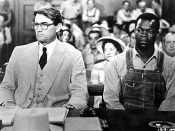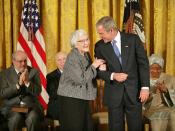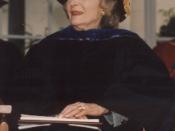Nelle Harper Lee was born on April 28, 1926, in Monroeville, Alabama, a sleepy small town similar in many ways to Maycomb, the setting of To Kill a Mockingbird. Like Atticus Finch, the father of Scout, the narrator and protagonist of To Kill a Mockingbird, Lee's father was a lawyer. Among Lee's childhood friends was the future novelist and essayist Truman Capote, from whom she drew inspiration for the character Dill.
These personal details notwithstanding, Lee maintains that To Kill a Mockingbird was intended to portray not her own childhood home but rather a nonspecific Southern town. "People are people anywhere you put them," she declared in a 1961 interview.
Yet the book's setting and characters are not the only aspects of the story shaped by events that occurred during Lee's childhood. In 1931, when Lee was five, nine young black men were accused of raping two white women near Scottsboro, Alabama.
After a series of lengthy, highly publicized, and often bitter trials, four of the nine men were sentenced to long prison terms. Many prominent lawyers and other American citizens saw the sentences as spurious and motivated only by racial prejudice. Later, it was revealed that the women who had accused the men were lying. There can be little doubt that the Scottsboro Case, as the trials of the nine men came to be called, served as a seed for the trial that stands at the heart of Lee's novel.
Lee began To Kill a Mockingbird in the mid-1950s, after earning a law degree and moving to New York to become a writer. She completed the novel in 1957 and published it, with revisions, in 1960, just before the peak of the American civil rights movement.
Critical response to To Kill a Mockingbird was mixed: a number of critics found the narrative voice of a nine-year-old girl unconvincing and called the novel overly moralistic. Nevertheless, in the racially charged atmosphere of the early 1960s, the book became an enormous popular success, winning the Pulitzer Prize in 1961 and selling over fifteen million copies. Two years after the book's publication, an Academy Award-winning film version of the novel, starring Gregory Peck as Atticus Finch, was produced. Meanwhile, the author herself had retreated from the public eye: she avoided interviews, declined to write the screenplay for the film version, and published only a few short pieces after 1961. To Kill a Mockingbird remains her sole published novel. Lee eventually returned to Monroeville and continues to live there.
In 1993, Lee penned a brief, one-paragraph foreword to her book. In it she asks that future editions of To Kill a Mockingbird be spared critical introductions. "Mockingbird," she writes, "still says what it has to say; it has managed to survive the years without preamble." The book remains a staple of high school and college reading lists, beloved by millions of readers worldwide for its appealing depiction of childhood innocence, its scathing moral condemnation of racial prejudice, and its affirmation that human goodness can withstand the assault of evil.




